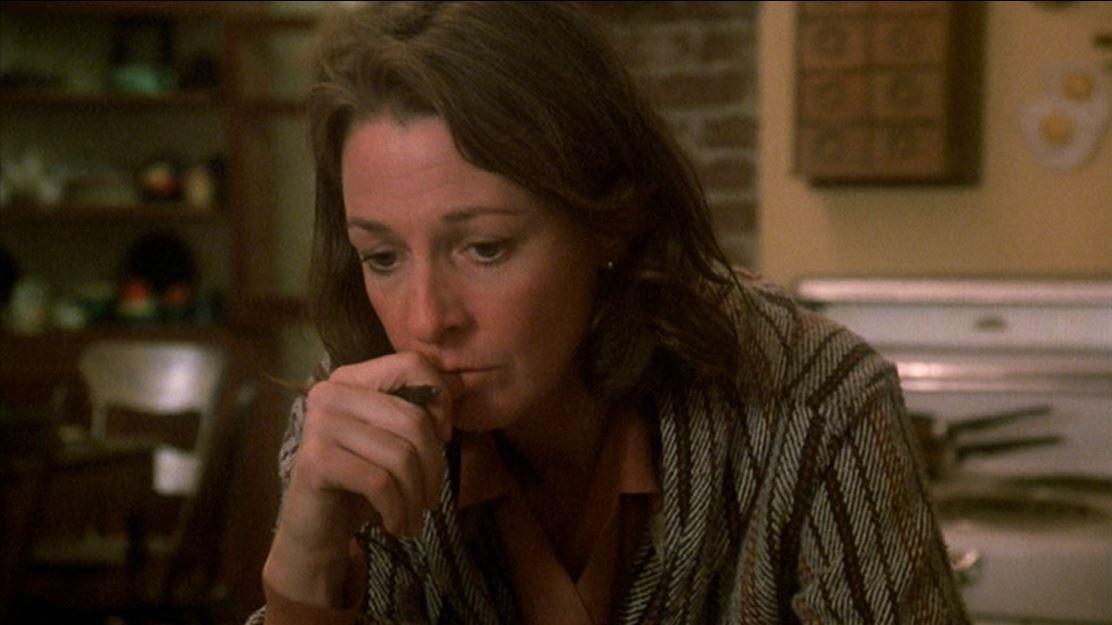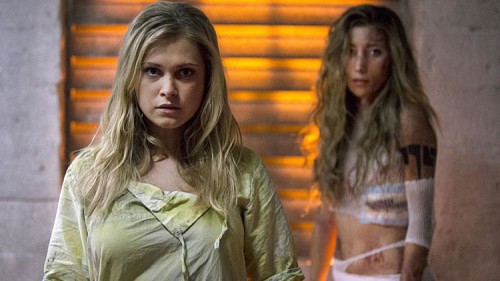This guest post written by Angela Beauchamp appears as part of our theme week on Ladies of the 1980s. | Spoilers ahead.
Zombies, plagues, nuclear destruction — nightmares of a catastrophic future are all the rage in recent cinema. Most often, we see bleak, desolate landscapes in which a masculine or androgynous action hero emerges to save the day, aka Mad Max or successor Furiosa. However, in the shadow of President Ronald Reagan’s aggressive anti-Soviet rhetoric and a doubling of the Pentagon budget in the early 1980s, a different kind of post-nuclear story emerged on television in the U.S. and the UK. The fictionalized present, rather than futuristic science fiction, introduced a cinematic living hell, not spectacular or heroic, nor hopeful for humanity’s future. On November 20, 1983, The Day After portrayed the realistic aftermath of nuclear war to an ABC audience of over half of the U.S. adult population. BBC’s Threads (1984), an even more brutal portrayal of life after the bombs, went on to sweep the BAFTA awards.
PBS American Playhouse produced Testament (1983), the third in this nuclear disaster triad, so impressive that Paramount picked up the film for theatrical release before it screened on television. A domestic drama about a northern California family dealing with the effects of radiation sickness and one death after another, Testament garnered a Best Actress Oscar nomination for lead Jane Alexander. In his 2002 book Atomic Bomb Cinema, Jerome Shapiro disparagingly designates this woman’s story as a “postnuclear feminist weepie” — the kind of language that calls feminists to take a closer look. Carol Amen published the original short story in Ms., and Lynne Littman directed the film, already with four Emmys and an Academy Award for documentary under her belt.
Shapiro disregards Testament because it is primarily about women’s suffering, yet this very acknowledgement of women’s powerlessness in a world that patriarchal governments have just blown up is feminist at its core. Acts like carefully sewing a shroud for her teenage daughter’s body displays the female protagonist’s courage. Perhaps it is just that no one had ever seen a post-apocalyptic movie before (or few since) without male protagonists or protagonists who take violent action to survive. Not many of us are a Furiosa at heart, but Testament is about an ordinary woman whose struggles might empower an ordinary viewer in the United States to take steps to join the nuclear freeze movement working to prevent a nuclear war. Children, seniors, women, and ethnic minorities are the survivors we see after white male authority figures disappear; the very people whose lives are usually subordinated are those who carry on.
It is hard to recreate the nuclear anxiety of this era now after the fall of the Soviet Union and the end of the Cold War in 1990, but Ronald Reagan and his administration actually spoke of limited nuclear attacks as a legitimate military tactic in the early 1980s. Anti-nuclear activism and marches on Washington were at their peak, and as a nineteen-year-old, I remember having a nightmare about waking up to a nuclear winter. When I actually awoke and looked at the florescent bulbs above the bed in my dorm room, I was unsure about the literal state of the world. The threat was real, and unlike our current cultural obsession with zombies (which likely serve as a reflection of fears of terrorism, pandemic, and the like), complete nuclear annihilation was a nightmare with time to prevent it from actually happening.
In Testament, Carol (Alexander) is a 1980s mom whose life revolves around her household, with three children and a husband (William Devane) who is, frankly, a jerk who rarely listens to either wife or kids. Later it becomes evident that he is a symbol for those in power who don’t listen to constituents. Carol’s small, northern California town is very white and middle-class, but Carol and her 13-year-old son Brad (Ross Harris) are differentiated by their friendship with Mike (Mako), a Japanese-American man who owns the nearby gas station. His son Hiroshi (Gerry Murillo) has Down’s syndrome and is an obvious metaphor for Hiroshima and Nagasaki. On one normal day when the kids are fighting over the television set and they are waiting for dad to return home from a business trip to San Francisco, the unthinkable happens. Flashes of intense light, the bombing of American cities, cut off a broadcast alert about a nuclear attack.
There are no mushroom clouds, no other immediate horrors, just the loss of electricity and a man who never comes home from his trip. Carols writes in her journal, “I’m so afraid. Everything looks the same.” They notice a strange dust on the next morning’s breakfast plates, the neighbor’s newborn quickly dies (a very young Kevin Costner has a bit part as the baby’s father), and then rationing food and batteries becomes a concern. Soon radiation sickness becomes apparent, as youngest child Scottie (Lukas Haas) succumbs after spending the night hemorrhaging in his mother’s arms, and since the graveyard is full, the family buries him in the backyard, wrapped with a child’s colorful bedding. Next, teenage daughter Mary Liz (Roxana Zal) passes away. This we know after watching Carol stitch the body into a crisp, white sheet.
The orphaned neighbor boy, the Asian gas station owner, the older man who runs the short wave radio, the elderly European piano teacher … everyone is dying. We know that Carol, Brad, and the ultimate innocent, Hiroshi, will die in the end, but they don’t give up. As director Littman said many years later, “I identify with the mother in the story, except especially as portrayed by Jane. She was much braver than I could ever be.” The story is about an everyday homemaker who spends her last days burying her children as she goes hungry and loses her hair, yet this woman is an inspiration. She doesn’t fold even after seriously contemplating suicide; she doesn’t lie about the future; she faces this end of life, end of her family, with an emotional honesty that is not the melodrama of the soap opera or a Lifetime movie. We don’t all have children and might live very different lives, but this 1983 film created by women gave the audience such a grim picture of the near future, without the excitement of special effects or the hope brought by overcoming obstacles, that it was a call to action, a message to avoid this outcome at all costs.
The initial story came to writer Carol Amen in a dream. In the DVD extra “Testament at 20,” Jane Alexander talks about her own nightmare of going on a camping trip and not being able to get home because of radiation. She felt the film was a catharsis for that nightmare, a working out of those fears, and soon after filming, she became a spokesperson for Physicians for Social Responsibility, an important activist group at the time. An adult Lukas Haas reads a letter that he dictated as a five-year-old to President Reagan, asking him “not to do the bombs.” He talks about fearing that every airplane overhead might be the one dropping a nuclear weapon.
Watching the film today calls back those fears, and although a homemaker as the protagonist may seem a bit old-fashioned, it is the long takes, slow pace, and muted colors that really call back to this period (a pleasure for those of us who enjoy “slow movies” and editing before shorter attention spans). Jane Alexander had already received an Emmy nomination for her portrayal of Eleanor Roosevelt, went on to win two Emmys, and became the director of the National Endowment for the Arts during its particularly embattled period in the mid-1990s. Testament was about facing the unthinkable in 1983 and being called to do something about it. Although replaced by other serious maladies, today we can count our lucky stars that those nightmares of full-scale nuclear war have largely gone away.
Angela Beauchamp is a cinema lover, film scholar, and most recently, a zombie mashup junkie. She is preparing to teach a course on Post-Apocalyptic Cinema in the fall.











